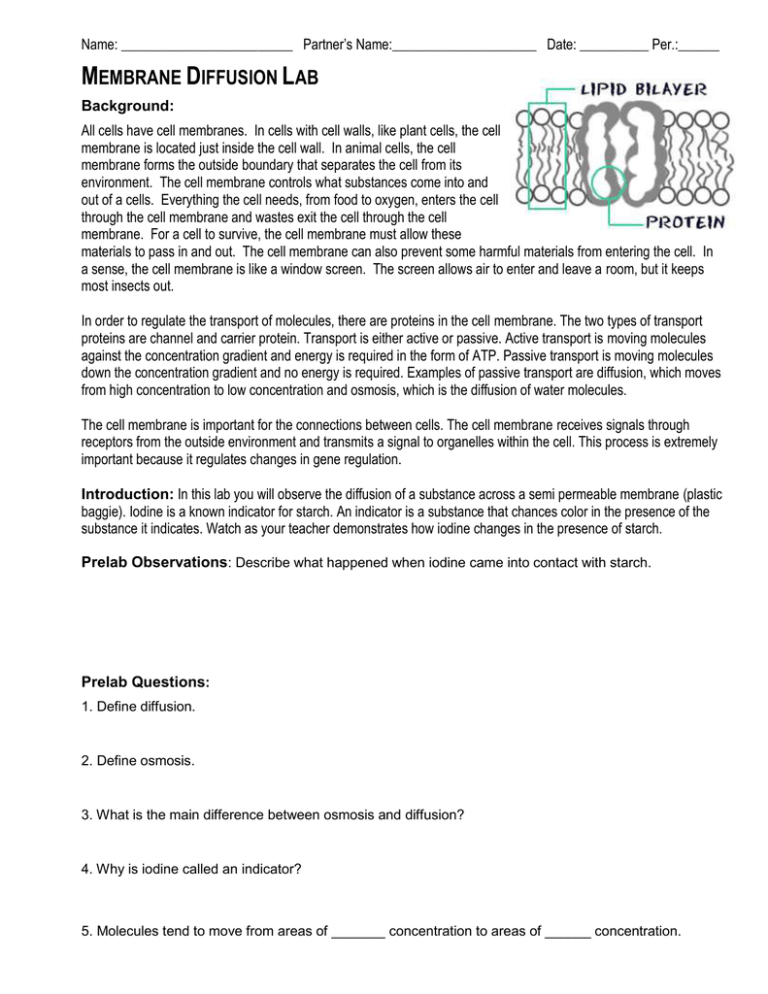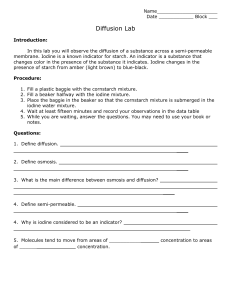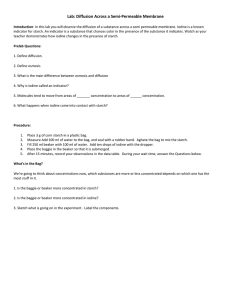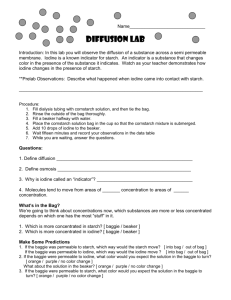Document 17774619
advertisement

Name: _________________________ Partner’s Name:_____________________ Date: __________ Per.:______ MEMBRANE DIFFUSION LAB Background: All cells have cell membranes. In cells with cell walls, like plant cells, the cell membrane is located just inside the cell wall. In animal cells, the cell membrane forms the outside boundary that separates the cell from its environment. The cell membrane controls what substances come into and out of a cells. Everything the cell needs, from food to oxygen, enters the cell through the cell membrane and wastes exit the cell through the cell membrane. For a cell to survive, the cell membrane must allow these materials to pass in and out. The cell membrane can also prevent some harmful materials from entering the cell. In a sense, the cell membrane is like a window screen. The screen allows air to enter and leave a room, but it keeps most insects out. In order to regulate the transport of molecules, there are proteins in the cell membrane. The two types of transport proteins are channel and carrier protein. Transport is either active or passive. Active transport is moving molecules against the concentration gradient and energy is required in the form of ATP. Passive transport is moving molecules down the concentration gradient and no energy is required. Examples of passive transport are diffusion, which moves from high concentration to low concentration and osmosis, which is the diffusion of water molecules. The cell membrane is important for the connections between cells. The cell membrane receives signals through receptors from the outside environment and transmits a signal to organelles within the cell. This process is extremely important because it regulates changes in gene regulation. Introduction: In this lab you will observe the diffusion of a substance across a semi permeable membrane (plastic baggie). Iodine is a known indicator for starch. An indicator is a substance that chances color in the presence of the substance it indicates. Watch as your teacher demonstrates how iodine changes in the presence of starch. Prelab Observations: Describe what happened when iodine came into contact with starch. Prelab Questions: 1. Define diffusion. 2. Define osmosis. 3. What is the main difference between osmosis and diffusion? 4. Why is iodine called an indicator? 5. Molecules tend to move from areas of _______ concentration to areas of ______ concentration. What is in the Bag? We are going to think about concentrations now, imagine we have completed the procedures for this lab which substances are more or less concentrated depends on which one has the most stuff in it. Sketch out the experimental setup outlined in the procedure section. 1. Is the baggie or beaker more concentrated in starch? 2. Is the baggie or beaker more concentrated in iodine? 3. Iodine solution: is the baggie or the beaker hypertonic? 4. Starch solution: is the baggie or the beaker hypertonic? 5. Which one is hypotonic in relation to starch, the baggie or beaker? Procedure: 1. Fill a plastic baggie with 40 mLs of corn starch solution (approximately 1/20 starch and 19/20 water) and tie a knot about 1-2 inches from the solution, making sure that there is not a lot of air in the baggie. 2. Fill a 150 mL beaker with 80 mLs water and add 20 drops of iodine. 3. Place the baggie in the beaker so that the corn starch solution is submerged in the iodine water mixture and the knot is above the level of the iodine. 4. Record your observations in the data table 5. Wait fifteen minutes and record your observations in the data table 6. If you have not yet done so, while you are waiting, answer the prediction questions. Make Some Predictions 1. If the baggie was permeable to starch, which way would the starch move, into or out of the bag? 2. If the baggie was permeable to iodine, which way would the iodine move, into or out of the bag? 3. If the baggie was permeable to iodine, what color would you expect the solution in the baggie to turn? What about the solution in the beaker? 4. If the baggie was permeable to starch, what color would you expect the solution in the baggie to turn? What about the solution in the beaker? Hypothesis: Make a prediction about what you think will happen in your experiment: Adapted from http://www.biologycorner.com/worksheets/diffusion.htm 2006 MLK Membrane Diffusion Lab Membrane Diffusion Data Table Starting Color Color after 15 minutes Solution in Beaker Solution in Baggie Post Lab Analysis 1. Based on your observations, which substance moved, the iodine or the starch? 2. How did you determine this? 3. The plastic baggie was permeable to which substance? 4. Is the plastic baggie selectively permeable? 5. Sketch the cup and baggie after 15 minutes. Use arrows to illustrate how diffusion occurred in this lab. 6. What would happen if you did an experiment in which the iodine solution was placed in the baggie, and the starch solution was in the beaker? Be detailed in your description. 7. If you needed to store iodine, is it a good idea to store iodine in a plastic baggie? Adapted from http://www.biologycorner.com/worksheets/diffusion.htm 2006 MLK Membrane Diffusion Lab


